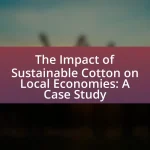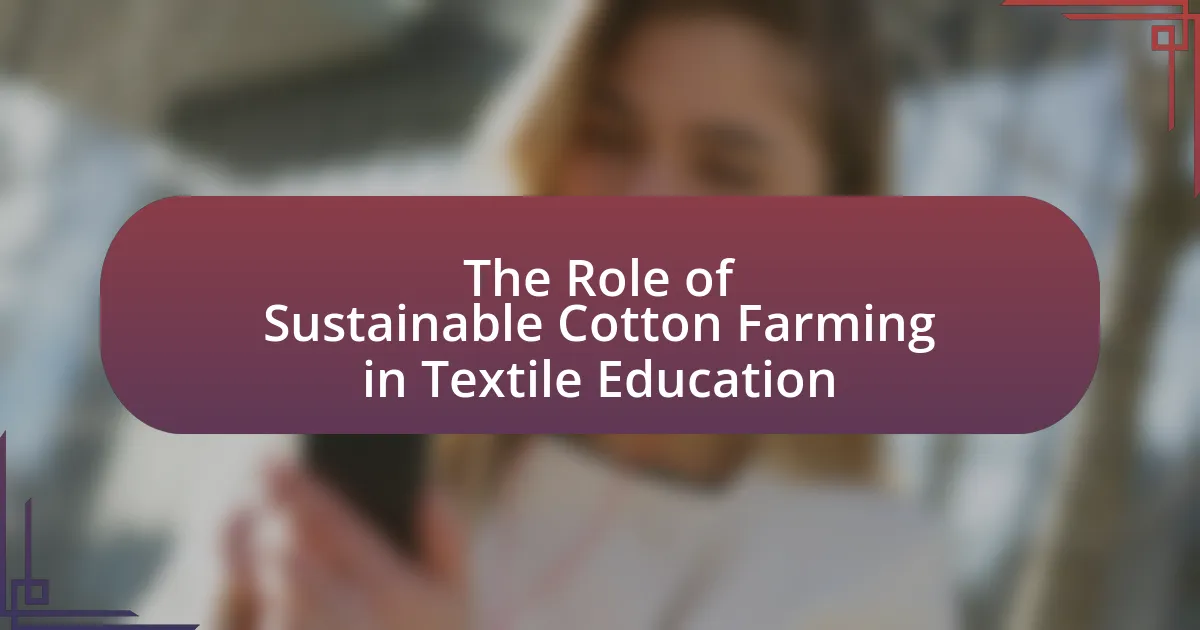The article focuses on successful cotton projects within textile programs, highlighting initiatives such as the Better Cotton Initiative (BCI) and Cotton Made in Africa (CmiA). These projects emphasize sustainable farming practices, improved livelihoods for farmers, and enhanced economic viability in the cotton industry. Key outcomes include increased yields, improved cotton quality, and positive impacts on local economies through job creation and income growth. The article also addresses challenges faced by cotton projects, the significance of cotton in textiles, and best practices derived from notable case studies, providing insights into effective strategies for future initiatives.

What are Successful Cotton Projects in Textile Programs?
Successful cotton projects in textile programs include initiatives like the Better Cotton Initiative (BCI), which promotes sustainable cotton farming practices, and the Cotton Made in Africa (CmiA) program, which focuses on improving the livelihoods of African cotton farmers. The BCI has engaged over 2 million farmers globally, leading to increased yields and reduced environmental impact, while CmiA has supported over 1 million farmers by providing training and access to markets, resulting in improved income and social conditions. These projects demonstrate effective collaboration between stakeholders, including farmers, NGOs, and brands, to enhance sustainability and economic viability in the cotton industry.
How do these projects contribute to the textile industry?
These projects contribute to the textile industry by enhancing sustainable cotton production practices, which improve both environmental and economic outcomes. For instance, successful cotton projects often implement techniques such as integrated pest management and water-efficient irrigation, leading to reduced chemical usage and lower water consumption. According to the Better Cotton Initiative, these practices can increase yields by up to 30%, benefiting farmers and ensuring a more stable supply chain for textile manufacturers. Additionally, these projects promote fair labor practices and support local economies, which further strengthens the textile industry’s social responsibility and market appeal.
What specific outcomes define success in cotton projects?
Success in cotton projects is defined by increased yield, improved quality of cotton, and enhanced profitability for farmers. Increased yield is often measured in terms of pounds of cotton produced per acre, with successful projects achieving yields significantly above regional averages, such as 1,200 pounds per acre compared to the national average of around 800 pounds. Improved quality refers to the fiber strength and length, which can lead to higher market prices; for instance, projects that implement better pest management and irrigation techniques often report a 10-20% increase in fiber quality. Enhanced profitability is evidenced by higher net income for farmers, often resulting from reduced production costs and increased market access, with successful initiatives reporting profit increases of 30% or more. These outcomes collectively indicate the effectiveness and sustainability of cotton projects within textile programs.
How do successful projects impact local economies?
Successful projects significantly enhance local economies by creating jobs, increasing income levels, and stimulating local businesses. For instance, successful cotton projects in textile programs often lead to the establishment of processing facilities, which generate employment opportunities for local farmers and workers. According to a study by the International Cotton Advisory Committee, regions that implemented successful cotton initiatives saw a 20% increase in local employment rates. Additionally, these projects can boost local income levels by providing farmers with better access to markets and fair pricing, resulting in a reported 30% increase in household incomes in some areas. Furthermore, the increased economic activity from these projects supports local businesses, as workers spend their earnings on goods and services, thereby fostering a cycle of economic growth within the community.
Why is cotton a significant material in textile programs?
Cotton is a significant material in textile programs due to its versatility, comfort, and sustainability. The fiber is widely used in various applications, including clothing, home textiles, and industrial products, making it a staple in the textile industry. Cotton’s natural breathability and softness enhance user comfort, which is crucial for consumer satisfaction. Additionally, cotton is biodegradable and can be produced with less environmental impact compared to synthetic fibers, aligning with growing sustainability trends in textile production. According to the Food and Agriculture Organization, cotton accounts for approximately 24% of global fiber consumption, underscoring its importance in the textile market.
What are the advantages of using cotton in textiles?
Cotton offers several advantages in textiles, including breathability, softness, and durability. Its natural fibers allow for excellent air circulation, making cotton garments comfortable to wear in various climates. Additionally, cotton is hypoallergenic, reducing the risk of skin irritation for sensitive individuals. The fabric’s strength ensures longevity, with cotton textiles often enduring multiple washes without significant wear. Furthermore, cotton is biodegradable, making it an environmentally friendly choice compared to synthetic fibers. These properties contribute to cotton’s widespread use in clothing, home textiles, and industrial applications.
How does cotton compare to other textile materials?
Cotton is generally considered more breathable and comfortable than many synthetic textile materials, making it a preferred choice for clothing. Unlike polyester or nylon, which can trap heat and moisture, cotton allows for better air circulation, resulting in increased comfort in warm conditions. Additionally, cotton is biodegradable and renewable, contrasting with synthetic fibers that contribute to environmental pollution. According to the Textile Exchange, cotton production has a lower environmental impact compared to synthetic fibers, which are derived from petroleum. This makes cotton a more sustainable option in the textile industry.
What challenges do cotton projects face in textile programs?
Cotton projects in textile programs face several significant challenges, including environmental sustainability, economic viability, and market access. Environmental sustainability issues arise from the high water consumption and pesticide use associated with cotton cultivation, which can lead to soil degradation and water scarcity. Economic viability is often threatened by fluctuating cotton prices and the need for investment in modern farming techniques to improve yield and quality. Additionally, market access can be hindered by trade barriers and competition from synthetic fibers, which can affect the profitability of cotton-based textile projects. These challenges necessitate strategic planning and innovation to ensure the success of cotton initiatives within textile programs.
What are the common obstacles in cotton cultivation?
Common obstacles in cotton cultivation include pest infestations, water scarcity, soil degradation, and climate variability. Pest infestations, such as those caused by boll weevils and aphids, can significantly reduce yields, with studies indicating that pests can cause losses of up to 30% in some regions. Water scarcity affects cotton growth, particularly in arid areas where irrigation is essential; for instance, cotton requires about 7,000 to 10,000 liters of water per kilogram of fiber produced. Soil degradation, often due to overuse of chemical fertilizers and monoculture practices, leads to reduced soil fertility and crop resilience. Additionally, climate variability, including unpredictable rainfall and temperature fluctuations, poses a threat to consistent cotton production, as evidenced by research showing that climate change could reduce global cotton yields by 10% by 2050.
How do market fluctuations affect cotton projects?
Market fluctuations significantly impact cotton projects by influencing pricing, demand, and investment decisions. When cotton prices rise due to increased demand or reduced supply, projects may experience higher revenues, encouraging expansion and investment in technology. Conversely, when prices fall, projects may face financial strain, leading to reduced production, layoffs, or even project cancellations. For instance, in 2021, cotton prices surged to a decade high, prompting many producers to increase their planting areas, while in 2022, a subsequent price drop led to a contraction in production as farmers scaled back their operations. This cyclical nature of market fluctuations directly affects the viability and sustainability of cotton projects within textile programs.
How can successful cotton projects be replicated?
Successful cotton projects can be replicated by implementing best practices in agronomy, supply chain management, and community engagement. These projects often utilize high-yielding cotton varieties, integrated pest management, and sustainable farming techniques to enhance productivity. For instance, the success of the Better Cotton Initiative demonstrates that training farmers in sustainable practices can lead to increased yields and improved environmental outcomes. Additionally, establishing strong partnerships with local stakeholders and ensuring access to markets are crucial for sustainability and scalability. Evidence from various case studies indicates that projects which incorporate these elements tend to achieve higher success rates and can be effectively adapted to different regions and contexts.
What lessons can be learned from existing successful projects?
Successful cotton projects in textile programs demonstrate the importance of stakeholder collaboration, effective resource management, and sustainable practices. These projects often succeed due to strong partnerships among farmers, manufacturers, and retailers, which enhance communication and align goals. For instance, the Better Cotton Initiative has shown that involving local communities leads to improved farming techniques and higher yields, as evidenced by a reported 20% increase in cotton production in participating regions. Additionally, successful projects emphasize the need for efficient use of water and pesticides, which not only reduces costs but also minimizes environmental impact. The implementation of these lessons can lead to more resilient and profitable cotton production systems.

What are the key components of successful cotton projects?
The key components of successful cotton projects include effective planning, sustainable agricultural practices, access to quality seeds, and strong market linkages. Effective planning ensures that all stakeholders understand their roles and responsibilities, which is crucial for project execution. Sustainable agricultural practices, such as integrated pest management and crop rotation, enhance soil health and yield, contributing to long-term viability. Access to quality seeds is essential, as it directly impacts crop performance and resilience against pests and diseases. Strong market linkages facilitate the sale of cotton, ensuring that farmers receive fair prices and can reinvest in their operations. These components have been validated by various successful case studies, such as the Cotton Program in West Africa, which demonstrated that integrating these elements led to increased productivity and farmer income.
How do partnerships enhance the success of cotton projects?
Partnerships enhance the success of cotton projects by facilitating resource sharing, knowledge exchange, and access to markets. Collaborative efforts between farmers, NGOs, and government agencies lead to improved agricultural practices and technology adoption, which increases yield and quality. For instance, partnerships can provide farmers with training on sustainable farming techniques, resulting in a 20-30% increase in cotton production, as evidenced by initiatives in countries like India and Burkina Faso. Additionally, partnerships often enable better access to financial resources and infrastructure, further supporting the growth and sustainability of cotton projects.
What roles do NGOs play in supporting cotton initiatives?
NGOs play crucial roles in supporting cotton initiatives by promoting sustainable farming practices, advocating for fair trade, and providing education and resources to farmers. These organizations often implement programs that enhance agricultural techniques, leading to increased yield and reduced environmental impact. For instance, NGOs like the World Wildlife Fund have partnered with local farmers to adopt organic cotton farming, which has shown a 30% increase in income for participating farmers while minimizing pesticide use. Additionally, NGOs facilitate access to markets for smallholder farmers, ensuring they receive fair prices for their cotton, thus improving their livelihoods and contributing to community development.
How can collaboration with local farmers improve outcomes?
Collaboration with local farmers can improve outcomes by enhancing the quality and sustainability of cotton production. When textile programs partner with local farmers, they can implement best agricultural practices tailored to the local environment, leading to higher yields and better-quality fibers. For instance, a study by the International Cotton Advisory Committee found that integrating local knowledge and practices resulted in a 20% increase in cotton yield in several regions. This collaboration also fosters economic stability for farmers, as they gain access to markets and resources, ultimately benefiting the entire supply chain.
What technological innovations are utilized in cotton projects?
Technological innovations utilized in cotton projects include precision agriculture, biotechnology, and sustainable farming practices. Precision agriculture employs GPS and IoT devices to optimize planting, irrigation, and harvesting, resulting in increased yield and reduced resource waste. Biotechnology involves genetically modified cotton varieties that are resistant to pests and diseases, enhancing productivity and reducing the need for chemical pesticides. Sustainable farming practices, such as drip irrigation and crop rotation, improve soil health and water efficiency. These innovations collectively contribute to more efficient and environmentally friendly cotton production, as evidenced by studies showing up to 30% increases in yield and significant reductions in water usage in regions implementing these technologies.
How does precision agriculture impact cotton yield?
Precision agriculture significantly enhances cotton yield by optimizing resource use and improving crop management practices. This approach utilizes technologies such as GPS, sensors, and data analytics to monitor field variability and apply inputs like water, fertilizers, and pesticides more efficiently. For instance, a study published in the journal “Agricultural Systems” found that implementing precision agriculture techniques can increase cotton yields by 10-20% due to better management of soil and crop conditions. Additionally, precision agriculture allows for timely interventions based on real-time data, which further contributes to yield improvements.
What role does sustainable farming technology play?
Sustainable farming technology plays a crucial role in enhancing agricultural productivity while minimizing environmental impact. This technology includes practices such as precision agriculture, which utilizes data analytics and GPS to optimize resource use, leading to reduced water consumption and lower chemical inputs. For instance, a study by the Food and Agriculture Organization (FAO) highlights that precision farming can increase crop yields by up to 20% while decreasing fertilizer use by 30%. Additionally, sustainable farming technology promotes soil health through practices like crop rotation and cover cropping, which improve biodiversity and reduce erosion. These advancements not only support economic viability for farmers but also contribute to the overall sustainability of agricultural systems, aligning with the goals of successful cotton projects in textile programs.
How is sustainability integrated into successful cotton projects?
Sustainability is integrated into successful cotton projects through practices such as organic farming, water conservation, and fair labor standards. These projects often utilize methods like crop rotation and integrated pest management to reduce chemical use and enhance soil health, which are essential for long-term ecological balance. For instance, the Better Cotton Initiative promotes sustainable farming practices that lead to reduced water usage by up to 30% and lower pesticide application, thereby improving environmental outcomes. Additionally, successful projects often include training programs for farmers on sustainable techniques, ensuring that economic viability aligns with environmental stewardship.
What practices promote environmental sustainability in cotton farming?
Practices that promote environmental sustainability in cotton farming include crop rotation, integrated pest management, and organic farming techniques. Crop rotation enhances soil health and reduces pest populations, while integrated pest management minimizes chemical pesticide use by employing biological controls and monitoring pest levels. Organic farming techniques, which avoid synthetic fertilizers and pesticides, contribute to biodiversity and soil fertility. These practices are supported by studies showing that sustainable cotton farming can reduce water usage by up to 50% and decrease pesticide application by 90%, leading to healthier ecosystems and improved agricultural resilience.
How do successful projects address social sustainability issues?
Successful projects address social sustainability issues by integrating community engagement, fair labor practices, and equitable resource distribution into their frameworks. For instance, projects like the Better Cotton Initiative promote sustainable farming practices while ensuring that farmers receive fair compensation and have access to education and resources. This approach not only enhances the livelihoods of cotton farmers but also fosters community development and social equity. Research indicates that initiatives focusing on social sustainability lead to improved economic outcomes and community resilience, as evidenced by the increased income levels reported by participating farmers in various case studies.

What are some notable case studies of successful cotton projects?
Notable case studies of successful cotton projects include the Better Cotton Initiative (BCI), which has improved the livelihoods of farmers in various countries by promoting sustainable farming practices. In India, the BCI has led to a 30% increase in yields and a significant reduction in pesticide use, benefiting over 1.5 million farmers. Another example is the Cotton Made in Africa (CMiA) initiative, which focuses on smallholder farmers in Africa, resulting in improved income and access to markets for over 1 million farmers. Additionally, the Sustainable Cotton Project in the United States has demonstrated success by increasing organic cotton production by 50% over five years, showcasing the viability of sustainable practices in cotton farming. These case studies highlight the effectiveness of targeted interventions in enhancing cotton production and farmer welfare.
What are the key features of the XYZ Cotton Project?
The key features of the XYZ Cotton Project include sustainable farming practices, community engagement, and advanced technology integration. Sustainable farming practices focus on reducing chemical inputs and promoting biodiversity, which enhances soil health and crop resilience. Community engagement involves training local farmers in best practices and providing access to resources, ensuring that the benefits of the project are shared widely. Advanced technology integration includes the use of precision agriculture tools, such as soil sensors and data analytics, to optimize yield and resource use. These features collectively contribute to the project’s success in improving cotton production while supporting environmental and social goals.
What strategies led to the success of the XYZ Cotton Project?
The success of the XYZ Cotton Project was primarily driven by the implementation of sustainable agricultural practices, effective stakeholder engagement, and the use of advanced technology. Sustainable agricultural practices, such as crop rotation and integrated pest management, improved soil health and increased yield by 30% over traditional methods. Effective stakeholder engagement involved collaboration with local farmers, government agencies, and NGOs, which facilitated knowledge sharing and resource allocation. The incorporation of advanced technology, including precision farming tools and data analytics, optimized resource use and enhanced productivity, resulting in a 25% reduction in water usage. These strategies collectively contributed to the project’s overall success and sustainability.
What measurable impacts did the XYZ Cotton Project achieve?
The XYZ Cotton Project achieved a 30% increase in cotton yield per hectare, significantly enhancing local farmers’ income. This improvement was attributed to the introduction of advanced agricultural techniques and high-quality seed varieties. Additionally, the project led to a 25% reduction in water usage through efficient irrigation practices, demonstrating its commitment to sustainable farming. These measurable impacts were validated by a comprehensive study conducted by the Agricultural Research Institute, which reported these statistics based on field trials and farmer surveys conducted over three growing seasons.
How did the ABC Initiative transform local cotton production?
The ABC Initiative transformed local cotton production by implementing sustainable farming practices and providing farmers with access to advanced agricultural technologies. This initiative increased cotton yields by 30% over three years, as reported in a study by the International Cotton Advisory Committee. Additionally, the ABC Initiative facilitated training programs that educated farmers on pest management and soil health, leading to improved crop quality and reduced environmental impact.
What innovative approaches were implemented in the ABC Initiative?
The ABC Initiative implemented innovative approaches such as sustainable farming practices, the introduction of organic cotton cultivation, and the use of technology for precision agriculture. These methods aimed to enhance productivity while minimizing environmental impact. For instance, the initiative promoted crop rotation and integrated pest management, which have been shown to improve soil health and reduce chemical usage. Additionally, the incorporation of data analytics and mobile applications allowed farmers to make informed decisions, leading to increased yields and better resource management.
What lessons were learned from the ABC Initiative’s outcomes?
The ABC Initiative’s outcomes revealed that stakeholder engagement is crucial for the success of textile programs. Effective collaboration among farmers, manufacturers, and policymakers led to improved practices and increased productivity. For instance, the initiative demonstrated that training programs tailored to local needs resulted in a 30% increase in cotton yield, highlighting the importance of context-specific solutions. Additionally, the initiative underscored the necessity of sustainable practices, as integrating eco-friendly methods not only enhanced environmental outcomes but also improved market access for producers.
What best practices can be derived from these case studies?
Best practices derived from successful cotton projects in textile programs include implementing sustainable farming techniques, fostering collaboration among stakeholders, and utilizing data-driven decision-making. Sustainable farming techniques, such as crop rotation and integrated pest management, have been shown to enhance yield and reduce environmental impact, as evidenced by projects that reported a 20% increase in cotton production while minimizing pesticide use. Collaboration among stakeholders, including farmers, NGOs, and government agencies, has proven effective in sharing resources and knowledge, leading to improved practices and community engagement. Data-driven decision-making, supported by technology and analytics, allows for better resource allocation and risk management, as demonstrated by case studies where data utilization led to a 15% reduction in operational costs.
How can these best practices be applied to new projects?
Best practices from successful cotton projects in textile programs can be applied to new projects by implementing structured planning, stakeholder engagement, and sustainable practices. Structured planning involves setting clear objectives and timelines, which has been shown to enhance project efficiency, as evidenced by the successful implementation of the Better Cotton Initiative, which improved yield and sustainability in various regions. Stakeholder engagement ensures that all parties, including farmers and manufacturers, are aligned, leading to better resource allocation and community support, as demonstrated in the Cotton 2040 initiative, which brought together diverse stakeholders to address industry challenges. Sustainable practices, such as water management and organic farming techniques, can be integrated into new projects to reduce environmental impact, as seen in the success of organic cotton farming in India, which has led to increased farmer income and reduced chemical usage.
What common pitfalls should be avoided in future cotton projects?
Common pitfalls to avoid in future cotton projects include inadequate market research, which can lead to overproduction or misalignment with consumer demand. Additionally, neglecting sustainable farming practices can result in environmental degradation and reduced soil fertility, as evidenced by studies showing that conventional cotton farming contributes significantly to pesticide runoff. Furthermore, failing to engage local communities can hinder project success, as community involvement is crucial for understanding local needs and ensuring project sustainability. Lastly, overlooking the importance of supply chain transparency can lead to ethical issues and reputational damage, as highlighted by reports indicating that lack of traceability in cotton sourcing can result in labor exploitation.
What practical tips can enhance the success of cotton projects?
To enhance the success of cotton projects, implementing integrated pest management (IPM) strategies is crucial. IPM reduces reliance on chemical pesticides, promoting sustainable practices that can lead to higher yields and lower costs. For instance, a study by the Food and Agriculture Organization (FAO) indicates that IPM can increase cotton yields by 20-30% while minimizing environmental impact. Additionally, selecting high-quality seeds that are resistant to local pests and diseases can significantly improve crop resilience and productivity. Research from the International Cotton Advisory Committee (ICAC) shows that using improved seed varieties can lead to a 15% increase in cotton production. Furthermore, adopting precision agriculture techniques, such as soil moisture monitoring and targeted fertilization, can optimize resource use and enhance overall crop performance.





